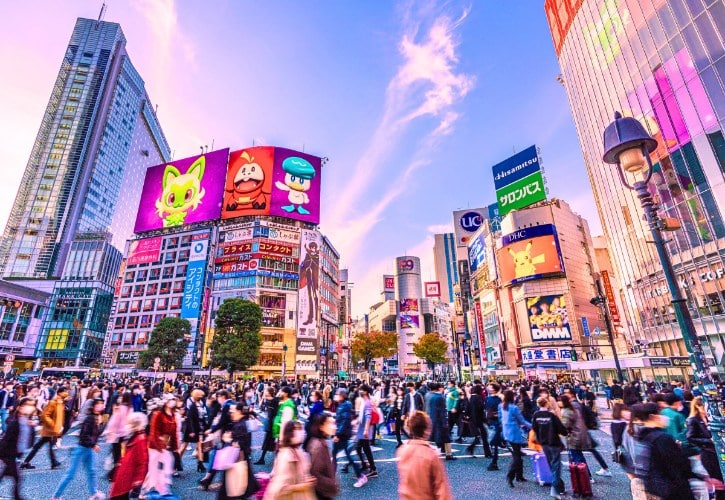
What are the must-do things in Tokyo? These 17 spots bring together the city’s bright lights, rich traditions, amazing food, and unforgettable fun.
You will walk neon streets, visit calm shrines, try local flavors, and see city views you will always remember.
This guide also shows you how to get there, so you can save time figuring out which exit to take and move around with ease.
I hope this helps you enjoy Tokyo in the best way. 😊
1. Kabukicho

Kabukicho is Tokyo’s most vibrant entertainment hub. You come for the neon, the photos, and the nightlife.
Visit after 6 PM to see the lights at their best. It is ideal for dinner and evening fun.
Highlights
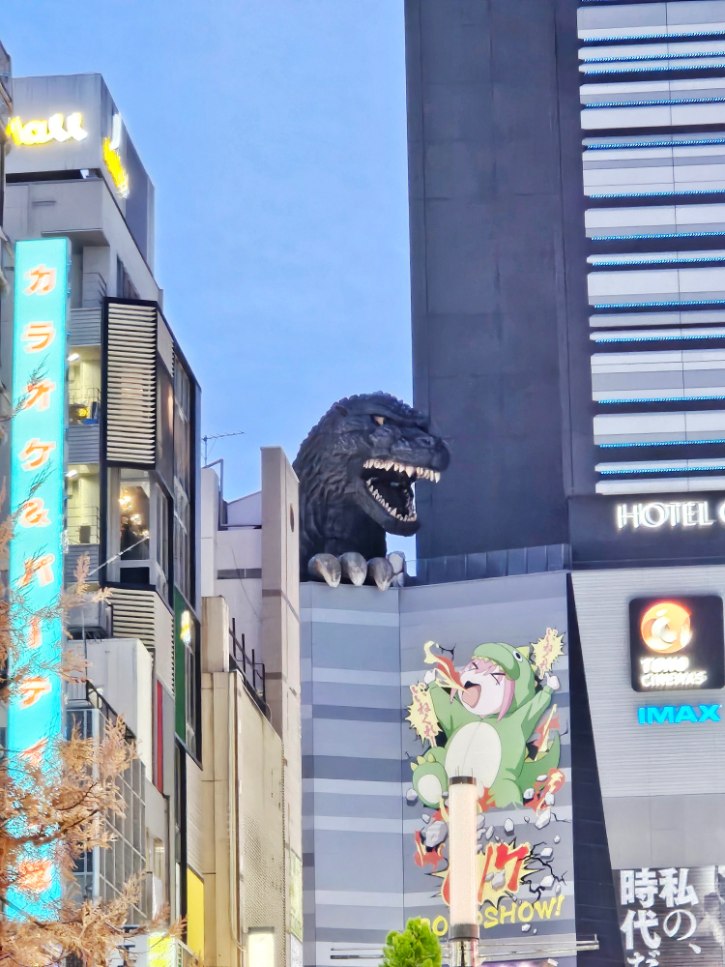
- Godzilla Head: A massive roaring statue on Hotel Gracery. Hourly shows with roars and steam from 12 PM to 8 PM.
- Don Quijote (Donki): Huge 24/7 discount store for snacks, beauty, electronics, clothes, and souvenirs.
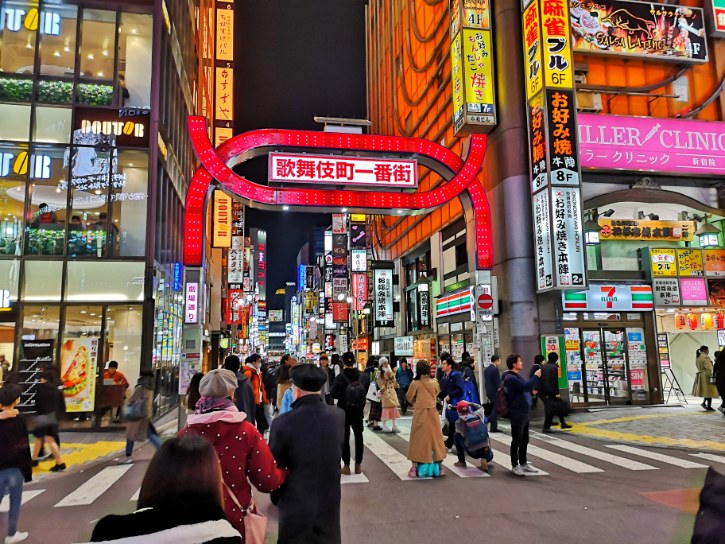
- Kabukicho Gate: Bright red neon arch and the district’s most famous photo spot, especially after dark.
- Golden Gai: Six narrow alleys with over 200 tiny themed bars. Most fit only 5 to 10 people.
Safety Tips
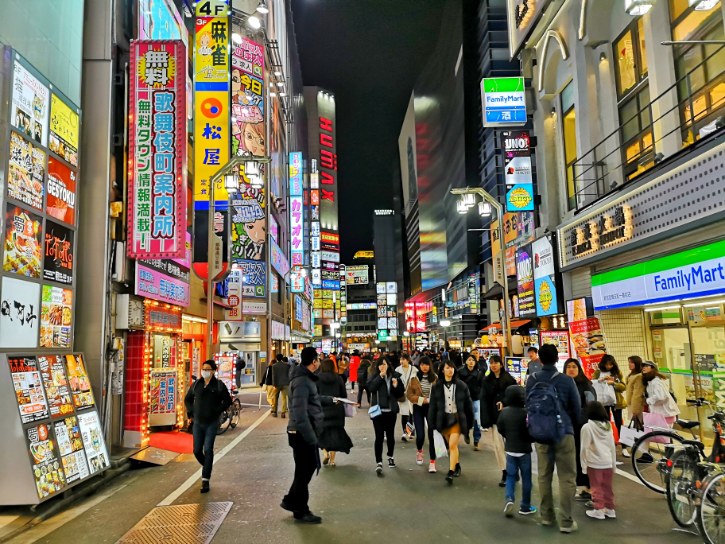
- Ignore street touts who push bars or clubs.
- Check prices outside before you sit.
- Keep bags zipped and close in crowds.
How to Get There
- JR: Any JR line to Shinjuku Station. Use East Exit. Walk about 8 minutes to the heart of Kabukicho.
- Tokyo Metro: Marunouchi Line to Shinjuku Station. Use East Exit. Walk about 8 minutes.
- Toei Oedo Line: Higashi-Shinjuku Station. Use Exit A1 for closer access.
Read More: 17 Best Things to Do in Shinjuku with My Perfect Itinerary
2. Tokyo Night & Light
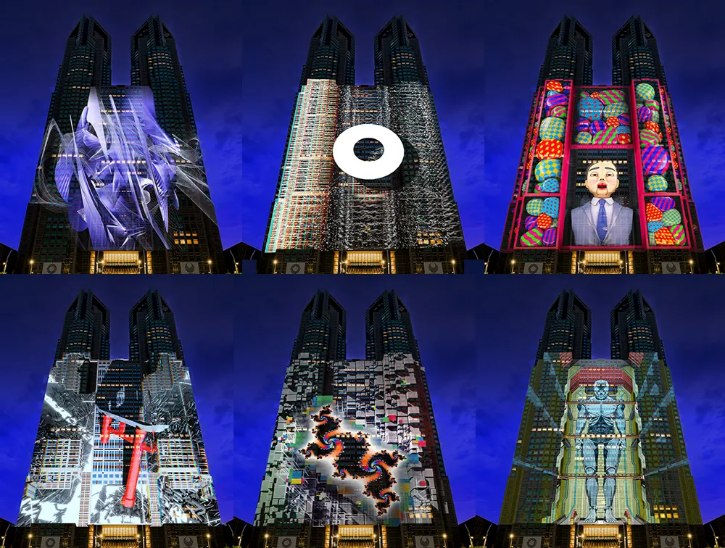
This is the world’s largest projection mapping show. You see art and technology blend on a massive scale. It is free and runs year-round. Every visit feels different.
How It Works
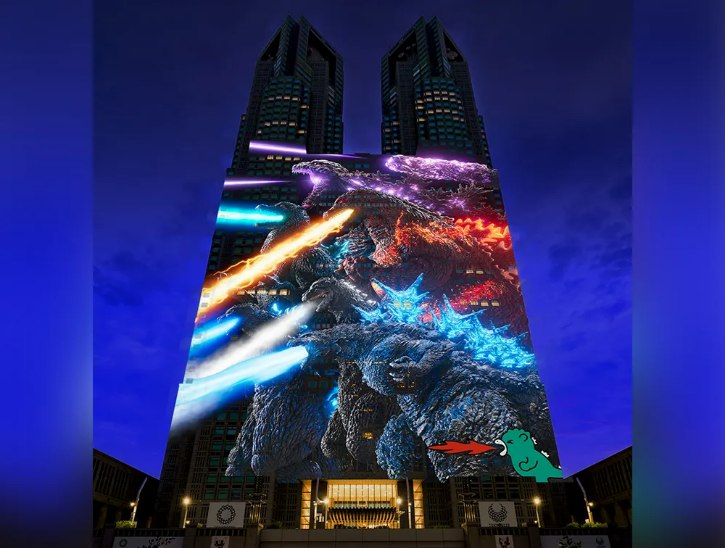
- Show format: Each show is 15 minutes. A new show starts every 30 minutes.
- Content: Rotating themes like Godzilla, PAC-MAN, and YOASOBI’s Idol, plus seasonal displays.
- Music: A mix of traditional and modern sounds that match the visuals.
Plan Your Visit
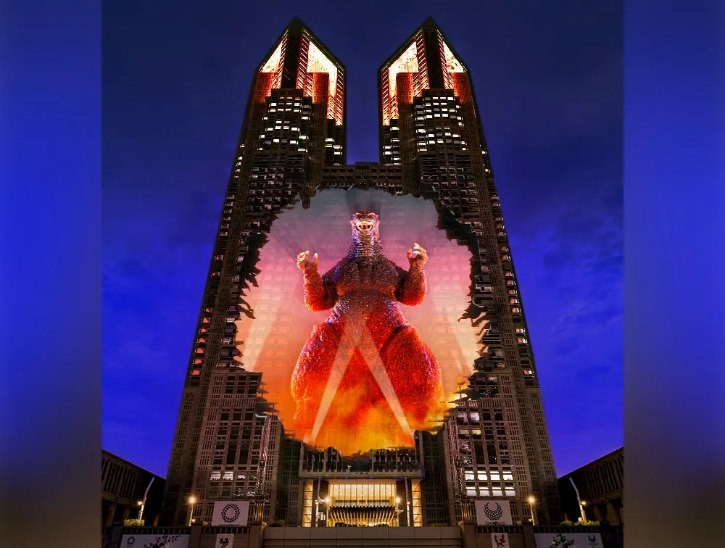
- Hours: 7:30 PM to 9:30 PM. Check the website for the day’s schedule.
- Arrive early: Be there about 30 minutes ahead for a better spot on busy nights.
- Best view: Citizens’ Plaza on the east side has clear sightlines and audio.
- Easy combo: Pair it with the Tokyo Metropolitan Government Building Observatory.
- Weather note: Canceled in bad weather, so look at the forecast.
How to Get There
- Toei Oedo Line: Tochomae Station Exit A4. The Tokyo Metropolitan Government Building is a 2-minute walk.
Read More: The Perfect 5-Day Tokyo Itinerary
3. Gotokuji Temple
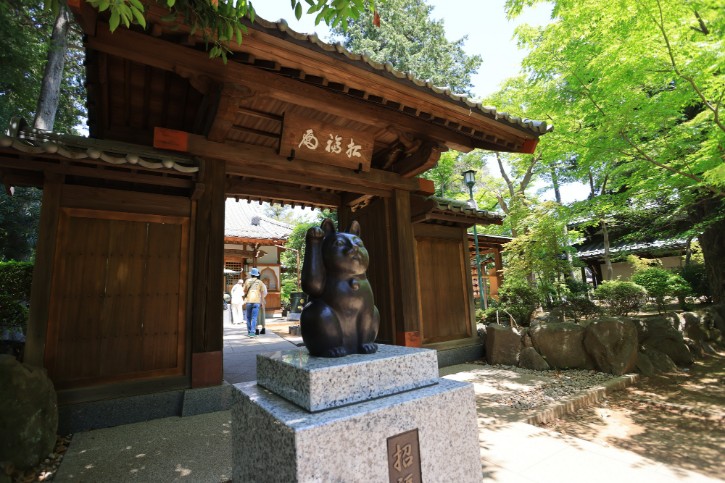
Gotokuji has a simple legend. Long ago, a temple cat raised its paw and beckoned a samurai inside. Moments later, lightning struck the spot he had just left.
The samurai believed the cat saved him. He rebuilt the temple to give thanks. That is why the beckoning cat, maneki-neko, is the temple’s symbol.
Do This
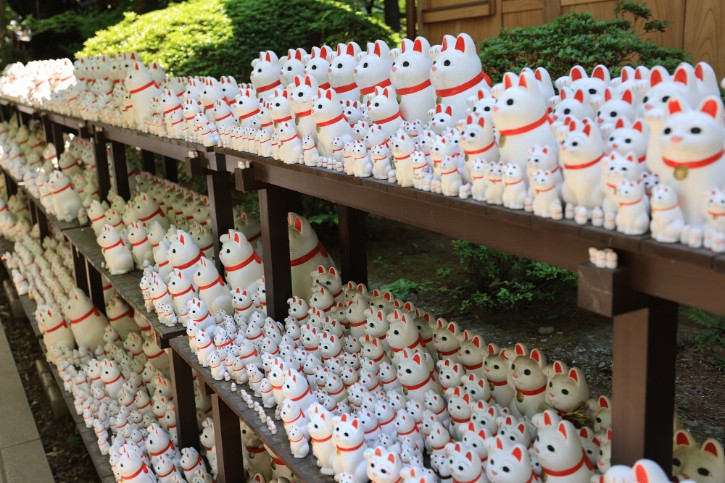
- Maneki-neko corner: Rows of lucky cats in many sizes make fun photos.
- Big cat statue: A friendly welcome near the main halls.
- Grounds walk: Traditional buildings, small cemetery, and a three-story pagoda. Try to spot the tiny carved cat.
- Temple practice: Light incense, offer a coin, ring the bell, and make a wish.
- Take home a cat: Buy a small statue as a souvenir or leave one with your prayer.
How to Get There
- Tokyu Setagaya Line: Ride to Miyanosaka Station (Sangen-jaya Exit). Walk about 5 minutes to the temple. You may catch the special Lucky Cat Train on this line, so check its schedule.
4. Shibuya

Shibuya is your go-to for trends, food, and nightlife. You will find youth fashion and big-name boutiques everywhere, so shopping is easy and fun.
After dark, the mood shifts to bars, clubs, and live music. Food options fit any budget, from quick bites to full meals.
Musts
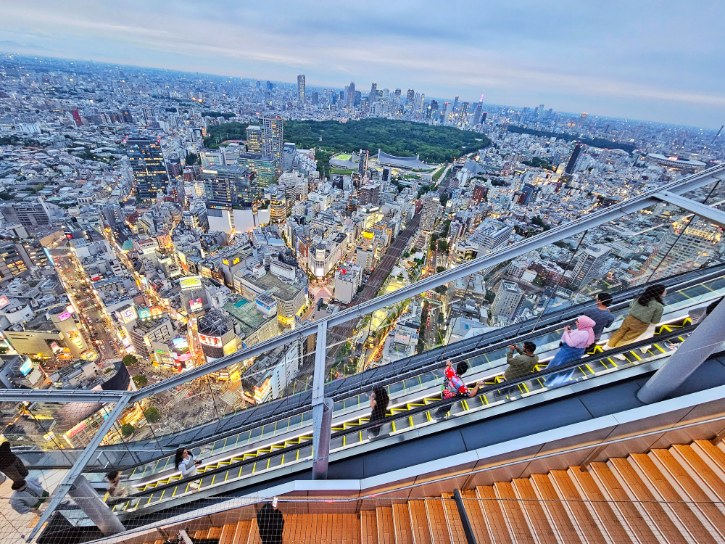
- Shibuya Sky: Step onto the rooftop deck for a 360° view of Tokyo. The skyline looks best at sunset when the city lights start to glow.
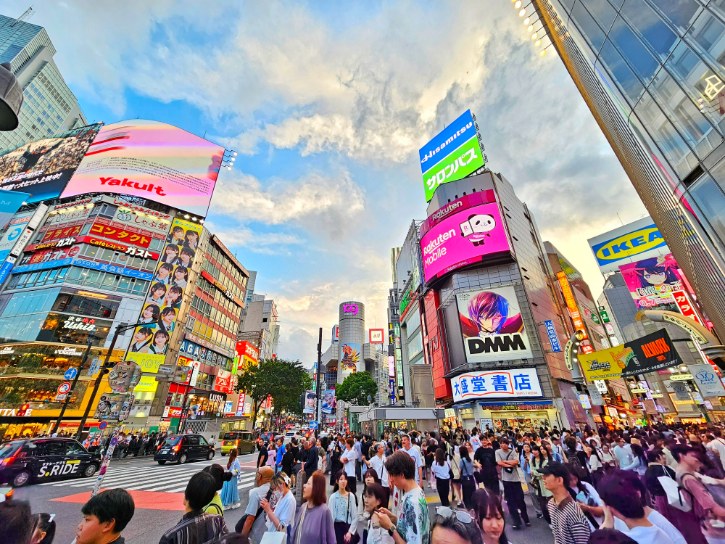
- Shibuya Scramble Crossing: Watch thousands of people cross from every direction at once. Wait for the signal and enjoy the wave of movement.
- Best views:
- Starbucks (second floor): Classic window view right over the crossing.
- Shibuya Sky deck at Shibuya Scramble Square: Unobstructed aerial view.
- MAGNET by SHIBUYA 109 rooftop: Outdoor look straight onto the scramble.
- Hoshino Coffee inside 109 MEN’S: A calmer seat with a good line of sight.
- Best views:
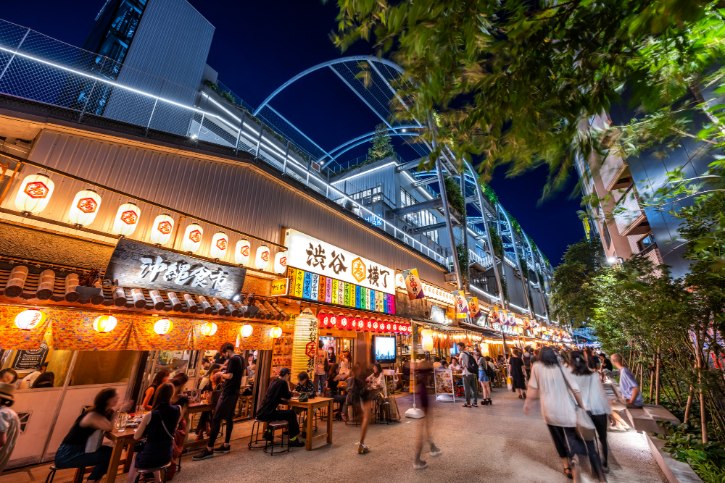
- Shibuya Yokocho: A retro-style alley with around 20 small eateries and bars. You can try regional dishes from all over Japan in one place, then hop to the next stall.
- What to eat: Toyama Black ramen. Hiroshima okonomiyaki layered with noodles. Miyazaki charcoal-grilled chicken. Okinawa soba. Chanko hotpot.
- Shibuya Center-Gai: The main street for fashion stores, quick eats, and entertainment. It is the easiest place to feel Shibuya’s everyday energy in one walk.
- Shibuya 109: The area’s iconic fashion mall. Floor after floor of trend-focused boutiques show you what is popular right now, especially with younger shoppers.
How to Get There
- Start at the Hachiko Exit (Exit 8). This is where most people begin exploring and it brings you straight to the Scramble.
- JR: Take the JR Yamanote Line to Shibuya Station. From the Hachiko Exit you step right into the crossing.
- Tokyo Metro: Take the Ginza Line, Hanzomon Line, or Fukutoshin Line to Shibuya Station. Follow signs to the Hachiko Exit (Exit 8).
Read More: 17 Top Things to Do in Shibuya with My Ideal Itinerary
5. teamLab Borderless Azabudai Hills
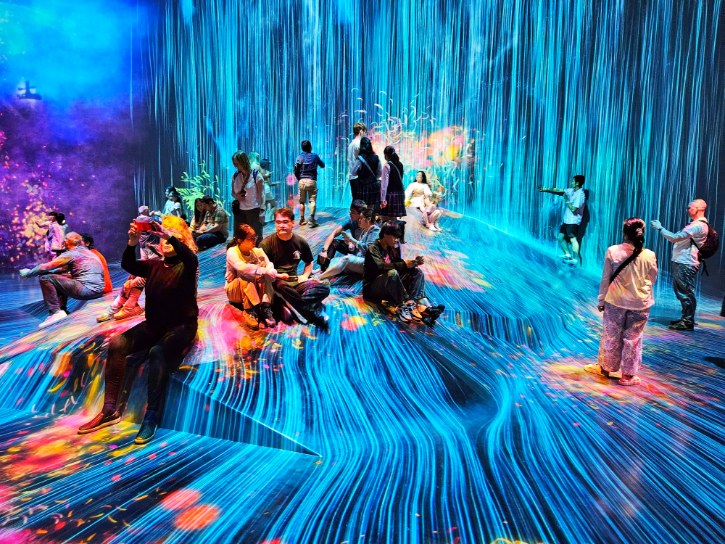
Digital art that moves with you. More than 50 works connect room to room, so you wander without a set route or time limit.
Art, science, and nature blend into one experience.
Don’t Miss
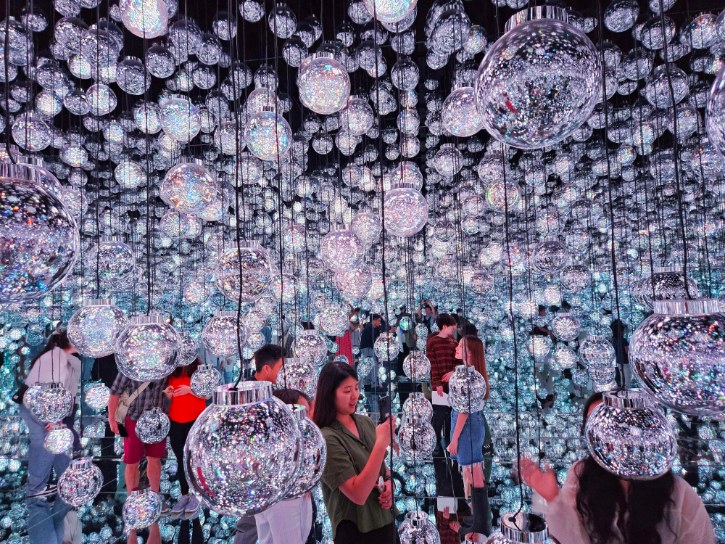
- Bubble Universe: A field of glowing spheres you can walk through.
- Light Sculpture: Giant forms of light that seem to flow toward you.
- Sketch Ocean: Draw a creature and watch it swim on the digital sea.
- Borderless World: Pieces drift, merge, and reappear as you explore.
Tips
- Mirrored floors: Skip loose skirts or baggy shorts.
- Wear darker colors for stronger reflections.
- Plan 2 to 3 hours.
How to Get There
- Tokyo Metro: Hibiya Line to Kamiyacho Station. Use Exit 5 for direct access.
6. Tokyo Disneyland and DisneySea
Tokyo Disneyland and DisneySea give you classic Disney magic with a Japanese touch. Go early to get more done and keep your day smooth.
Tokyo Disneyland
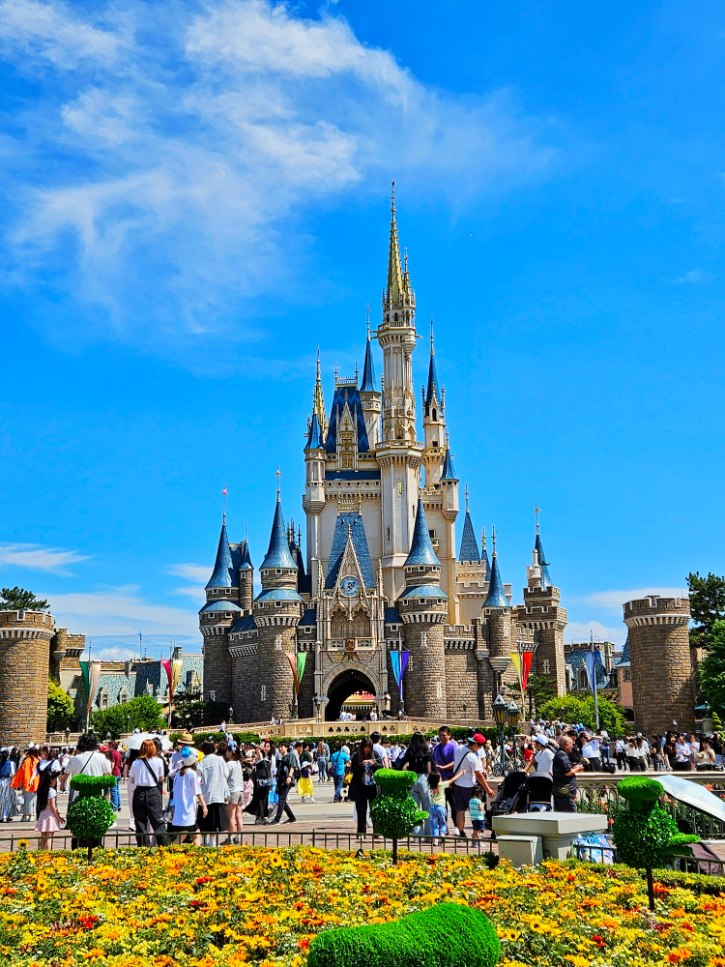
- Areas: World Bazaar, Adventureland, Westernland, Critter Country, Fantasyland, Toontown, Tomorrowland.
- Rides to target: Enchanted Tale of Beauty and the Beast, Space Mountain, Pooh’s Hunny Hunt, Monsters, Inc. Ride & Go Seek, and it’s a small world.
Tokyo DisneySea
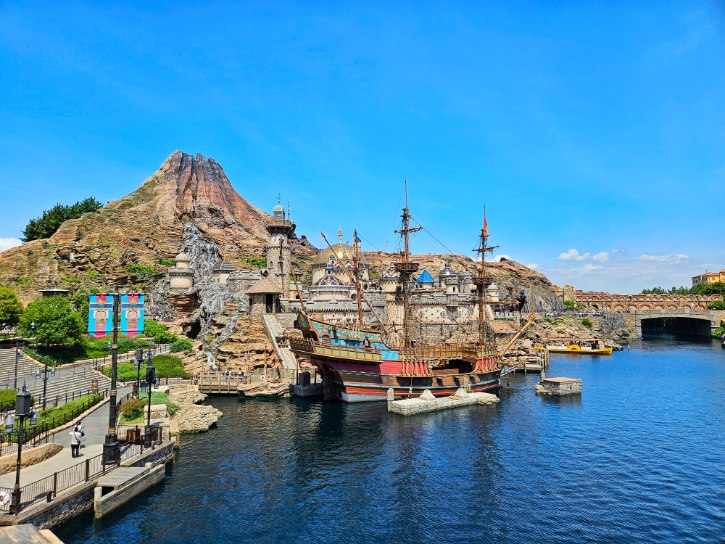
- Only one of its kind: Eight ports themed around the sea with a grown-up feel.
- New draw: Fantasy Springs with Frozen, Tangled, and Peter Pan areas.
- Headliners: Journey to the Center of the Earth, Soaring: Fantastic Flight, Anna and Elsa’s Frozen Journey, Rapunzel’s Lantern Festival.
Smart Planning
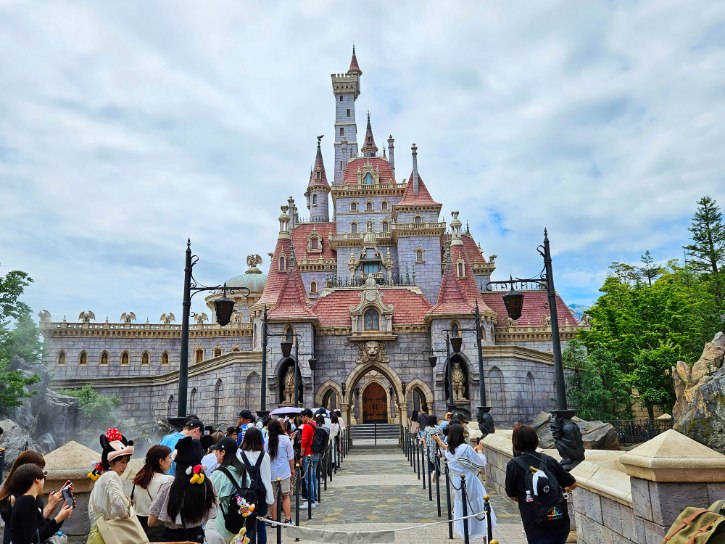
- Tickets: Buy online. There are no on-site sales.
- Before you go: Install the Tokyo Disney Resort app. Use it to check wait times, get free Priority Pass, buy Disney Premier Access, and order food.
- When you enter the park: Open the app and take your first Priority Pass right away. Passes are limited each day.
- Skip long lines: Buy Disney Premier Access in the app for the rides you care about most.
- Arrive early: Be at the gate at least one hour before opening so you can secure passes and ride more.
How to Get There
Disneyland:
- Take the JR Keiyo Line or JR Musashino Line to Maihama Station.
- Exit via the South Exit.
- Follow the crowd and go straight.
- It is about 5 minutes to the Tokyo Disneyland entrance.
DisneySea:
- From Tokyo Station, ride the JR Keiyo Line or JR Musashino Line to Maihama Station. The trip takes about 15 minutes.
- Exit via the South Exit at Maihama.
- Walk about 2 minutes to Resort Gateway Station.
- Take the Disney Resort Line to Tokyo DisneySea Station. It takes about 9 minutes and costs 260 yen for adults.
- From Tokyo DisneySea Station, walk 1 minute to the park entrance.
Read More: How to Go to Tokyo Disneyland and DisneySea (Full Guide)
7. Asakusa
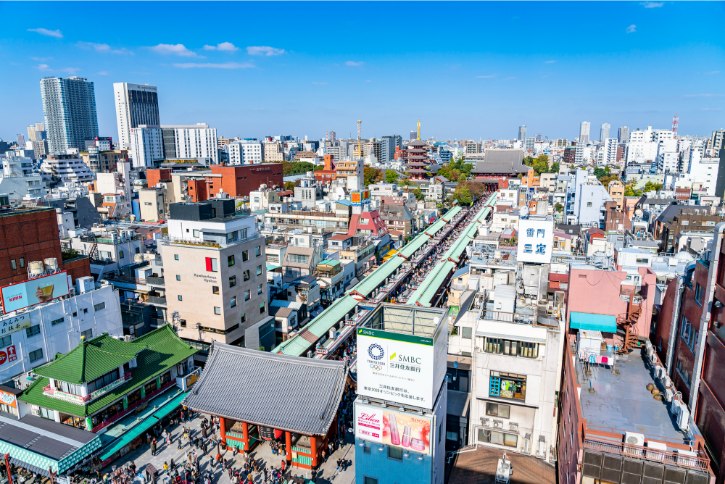
Asakusa lets you step into old Tokyo. Start at Sensoji, where a giant red lantern and a five-tier pagoda set the scene.
Stroll Nakamise Street for classic snacks and simple souvenirs. For extra charm, rent a kimono or take a short rickshaw ride.
Key Stops
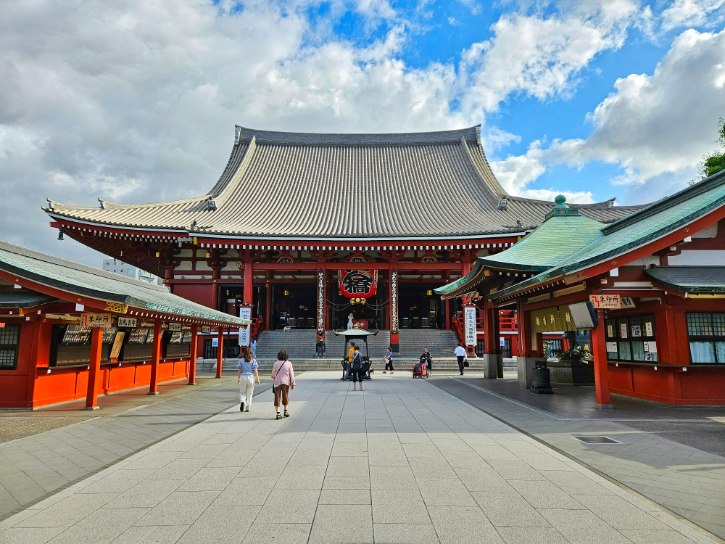
- Sensoji Temple: Start at Kaminarimon Gate with the giant red lantern. Walk through to Sensoji and try an omikuji (fortune paper) to read your luck.
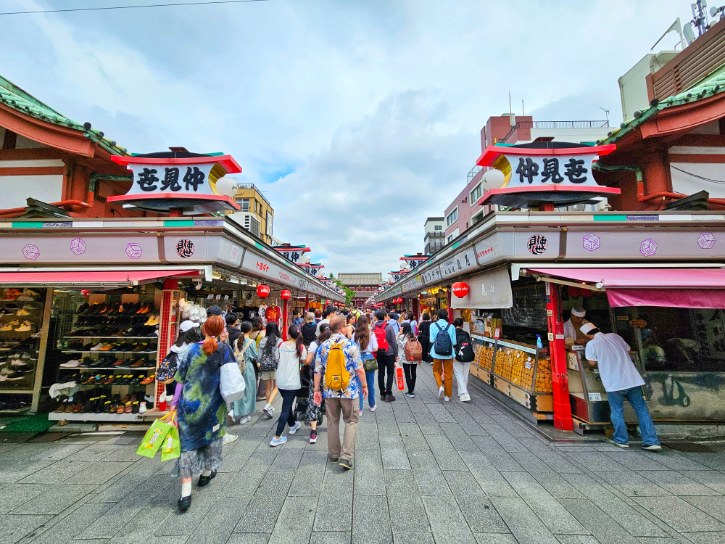
- Nakamise treats and finds:
- Dango (Asakusa Soratsuki): Chewy mochi on a skewer with fresh strawberries and a sweet bean topping. Comes in different flavors.
- Kibi dango (Kibidango Azuma): Soft rice cakes lightly dusted with soybean powder.
- Ningyo yaki (Kimuraya): Bite-size cakes shaped like dolls or landmarks. Filled with sweet bean paste.
- Rice crackers (Tokiwado Kaminari-okoshi Honpo): Crackers grilled fresh in a range of flavors.
- Age manju (Asakusa Kokonoe): Freshly fried buns with red bean, matcha, or chocolate filling.
- Asakusa Menchi: Juicy, crispy meat croquettes.
- Melon pan (Kagetsudo): Sweet bread with a crackly sugar crust.
How to Get There
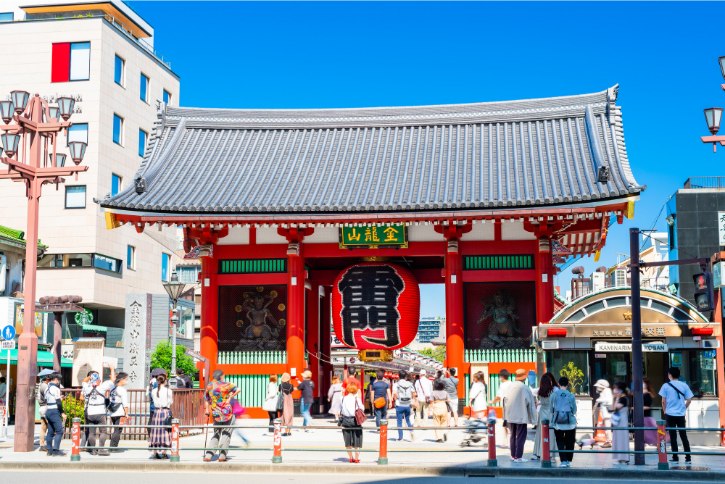
- Tokyo Metro: Ginza Line to Asakusa Station Exit 1 for direct access to Nakamise Street.
- Toei Subway: Asakusa Line to Asakusa Station Exit A4, then walk about 5 minutes.
- Tobu Railway: Tobu Skytree Line to Asakusa Station main exit, then walk about 5 minutes
Tip: The large Kaminarimon Gate marks the entrance.
Read More: 17 Wonderful Things to Do in Asakusa
8. Tokyo Skytree
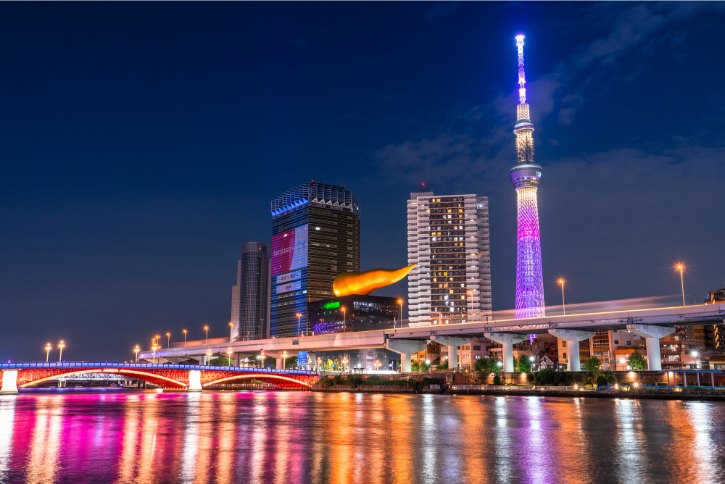
A 634-meter giant with sweeping 360-degree views. It has shaped the skyline since 2012 and gives you a sense of how vast Tokyo is.
Decks
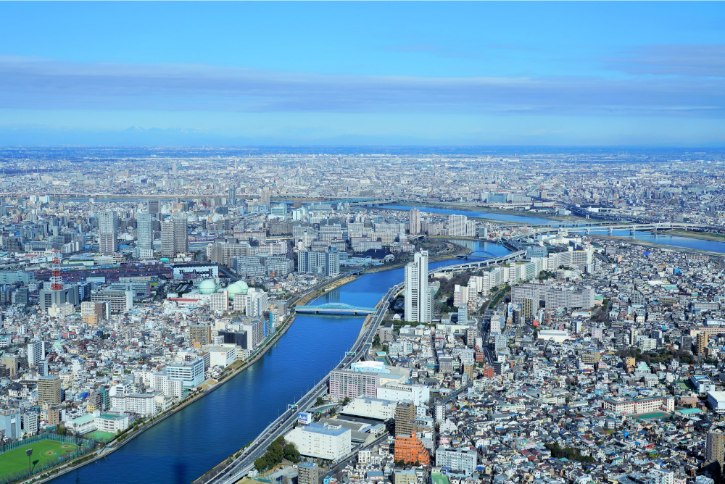
- Tembo Deck at 350 meters: Three levels, glass floor spots, and digital telescopes.
- Tembo Galleria at 450 meters: A sloped spiral walkway with even wider views.
How to Get There
- Tobu Railway: Tobu Skytree Line to Tokyo Skytree Station. Directly connected.
- Tokyo Metro: Hanzomon Line to Oshiage (Skytree) Station Exit B3 for direct access.
- Toei Subway: Asakusa Line to Oshiage (Skytree) Station Exit A2, then follow signs.
9. Toyosu Senkyaku Banrai
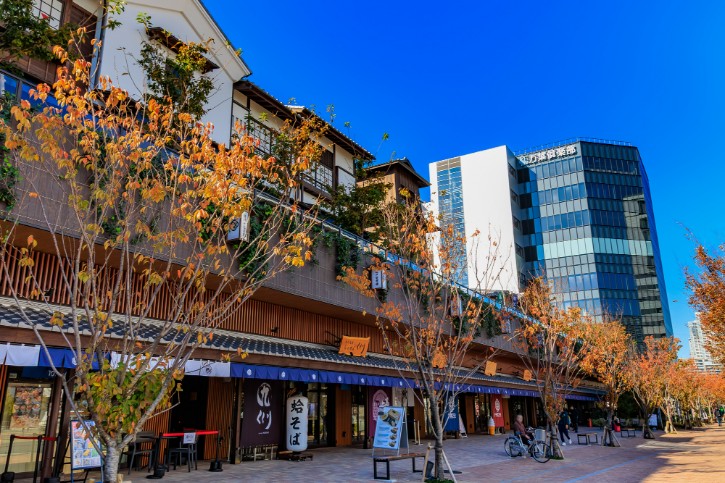
Old Edo style meets modern comfort by the bay.
Eat seafood connected to nearby Toyosu Market, then soak in city hot springs with real onsen water from Hakone and Yugawara.
The 8th-floor footbath is free and looks over Tokyo Bay. The baths are open 24 hours.
Good Stops
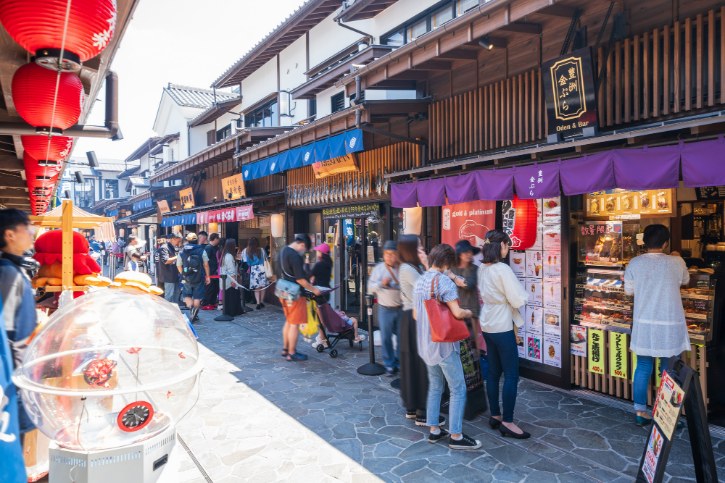
- Toyosu Menuki Odori: Edo-style eateries for classics like eel and sushi.
- Mekiki Yokocho: “Connoisseur Alley” for seasonal bites picked by market pros.
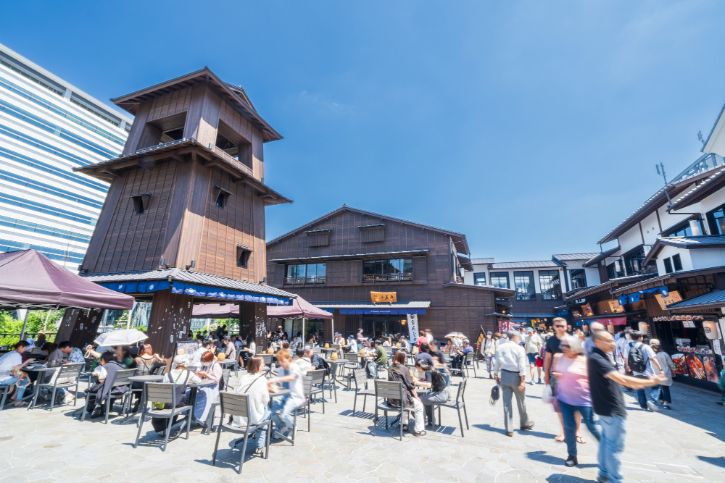
- Toki no Kane Square: Edo-inspired clock tower and photo spot.
- Tokyo Toyosu Manyo Club: Outdoor baths, saunas, lounges, and bay views.
- Scenic Ashiyu Foot Bath Garden: Free soak with night panoramas.
How to Get There
- Yurikamome Line: Shijo-mae Station. Use the pedestrian deck (Exit 1A). It is about a 4-minute walk.
Read More: 10 New Things to Do in Tokyo
10. Warner Bros. Studio Tokyo
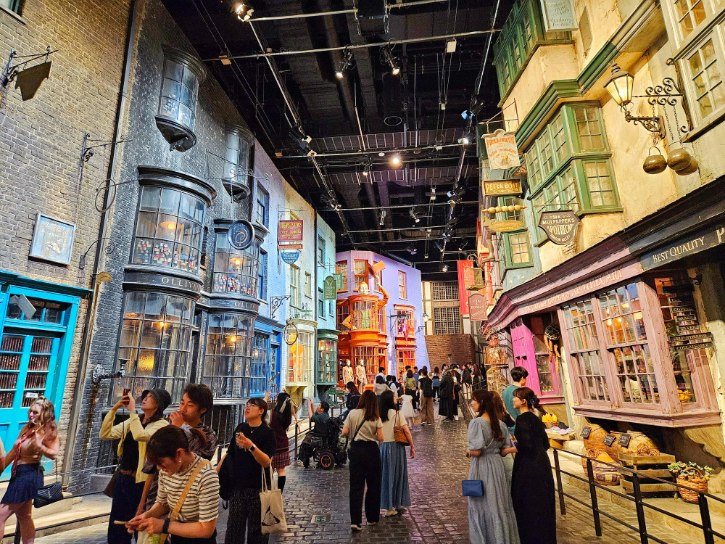
This is the largest indoor Harry Potter experience in the world and the first in Asia. You walk through real film sets.
You see original props and costumes. You can also try hands-on activities like spell casting and broomstick photo spots.
Tokyo adds exclusive set pieces you will not find anywhere else.
Set Pieces to See
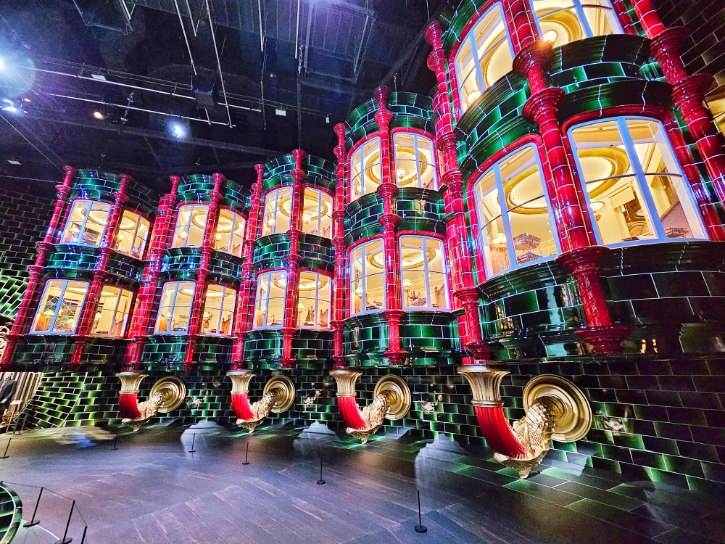
- Ministry of Magic: A huge, Tokyo-only set that lets you step into the wizarding government.
- Great Hall: Enter Hogwarts’ dining hall with floating candles and screen-used costumes.
- Diagon Alley: Stroll past Ollivander’s, Gringotts, and the Weasleys’ shop.
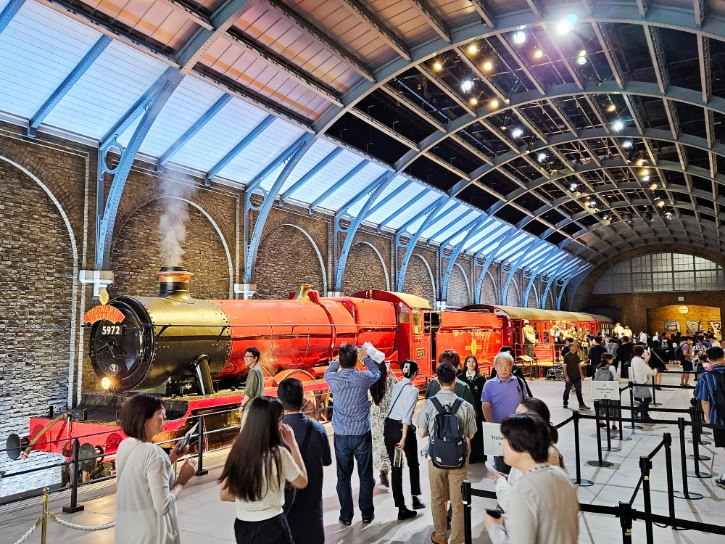
- Platform 9¾: Pose pushing your trolley through the wall, then board the Hogwarts Express.
- Forbidden Forest: Meet creatures like Buckbeak and Aragog and try your own Patronus charm.
How to Get There
- Seibu Railway: Take the Seibu Ikebukuro Line to Toshimaen Station. Exit the station and walk straight for about 2 minutes.
- Toei Subway: Ride the Oedo Line to Toshimaen Station. Use Exit A2, turn left at the street in front of 7-Eleven, then walk about 5 minutes.
11. Akihabara
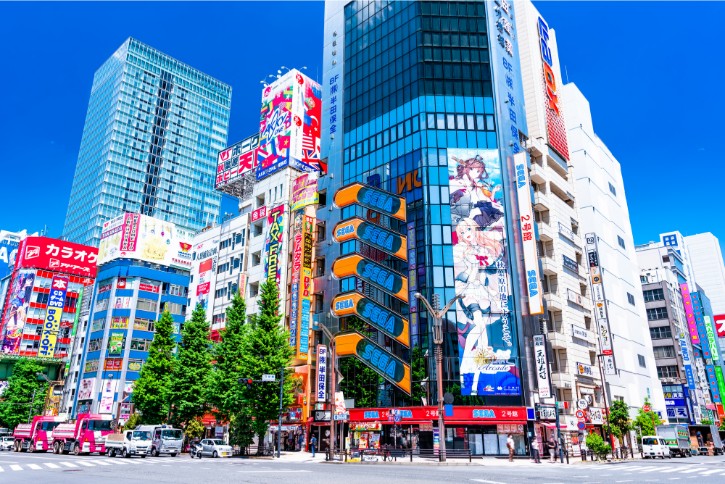
Akihabara is the center of electronics and otaku culture. You will see huge multi-floor stores next to tiny specialist shops.
Anime, manga, games, and themed cafes are everywhere. You can browse, play, and eat in one compact area.
Colorful buildings and giant signs make great photos, especially on busy days.
Where to Go
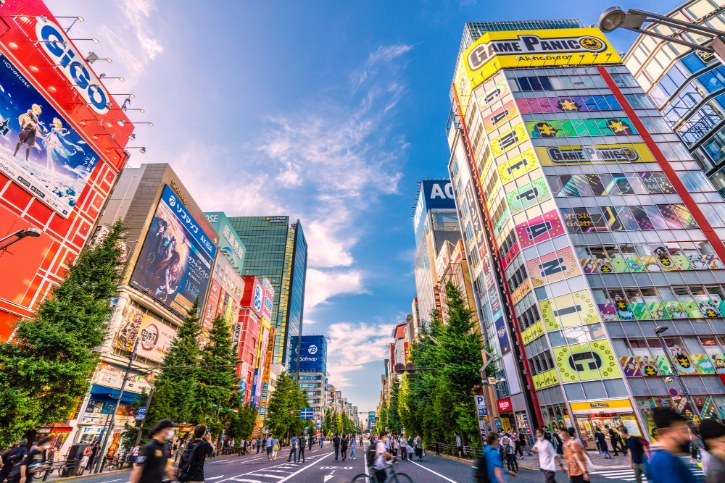
- Yodobashi Camera: A massive, multi-story store for gadgets and appliances. Find smartphones, cameras, gaming gear, and more. Tourists can shop tax-free.
- Maid café: Try a themed cafe where staff dress as maids. Expect playful service, short performances, and cute decorated food and drinks.
- Mandarake Complex: Multi-story shop focused on anime and manga. Browse figurines, collectibles, and rare items.
- Akihabara Radio Kaikan: Landmark building with 10 floors of shops. Great for electronic parts and anime figures. Many small stores are run by passionate specialists.
- Chuo Dori: The main street with electronics and anime shops. Best on Sundays when it becomes pedestrian-only. It is also good for photos.
How to Get There
- Start point: Begin at the Electric Town Exit. Most people start exploring here.
- JR: Take the JR Yamanote Line, JR Chuo-Sobu Line, or JR Keihin-Tohoku Line to Akihabara Station. From the Electric Town Gate, you are right in the core with Radio Kaikan and Chuo Dori ahead.
- Tokyo Metro: Ride the Hibiya Line to Akihabara Station and use Exit 3. It is a short walk to Electric Town.
- Tsukuba Express (TX): Get off at Akihabara Station and use Exit A1 for quick access to Electric Town and Radio Kaikan.
12. Ginza
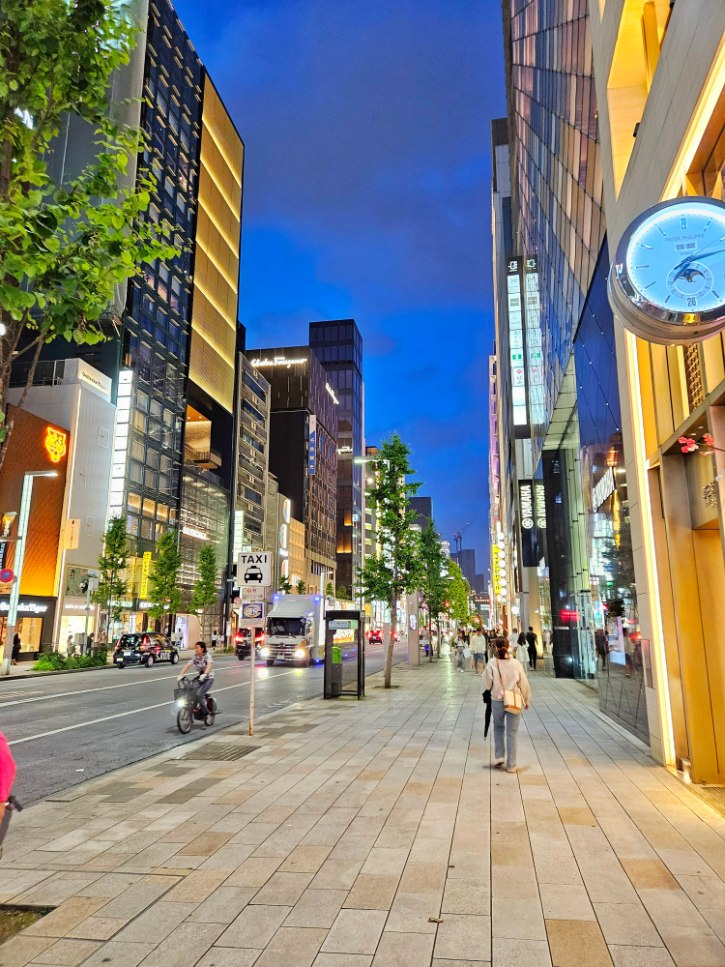
Ginza is Tokyo’s top luxury shopping area. You see big-name brands, high-end department stores, and small boutiques in every direction.
The buildings are eye-catching because this district sits on some of the world’s most expensive real estate.
On weekends, Chuo Dori closes to cars, so you can stroll in the street at a relaxed pace.
It is also a great place to eat, from Michelin-star restaurants to famous sushi counters.
Don’t Miss
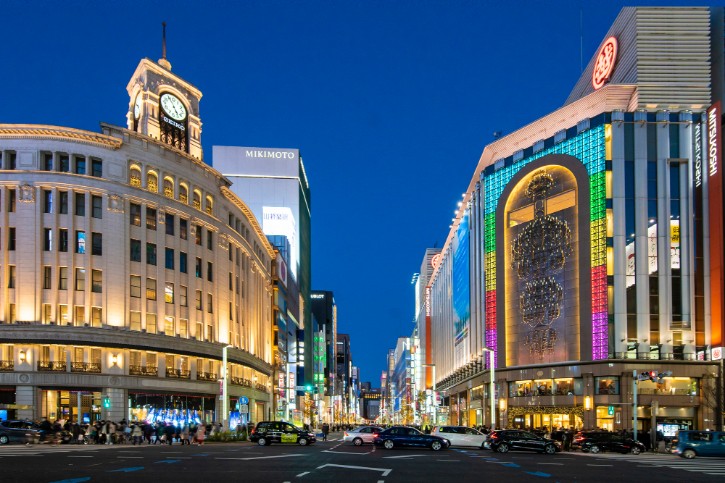
- Ginza Wako: Iconic clock-tower store. Go for luxury jewelry, watches, and traditional crafts. A classic Ginza landmark.
- Chuo Dori (Central Avenue): Main shopping street. Pedestrian-only on Saturday and Sunday afternoons. Easy walking and great photo spots.
- GINZA SIX: More than 200 stores in one complex. Head up to the rooftop garden for city views.
- Art Aquarium Ginza: Art with live goldfish in glowing, musical displays.
How to Get There
- JR: Yamanote Line or Keihin-Tohoku Line to Yurakucho Station. Use the Ginza Exit. Walk about 8 minutes to Chuo Dori.
- Tokyo Metro: Ginza Line, Marunouchi Line, or Hibiya Line to Ginza Station Exit A2. Chuo Dori is directly accessible.
- Toei Subway: Asakusa Line to Higashi-Ginza Station Exit A2. Walk about 2 minutes to Chuo Dori.
Read More: Top 17 Things to Do in Ginza
13. Tsukiji Outer Market
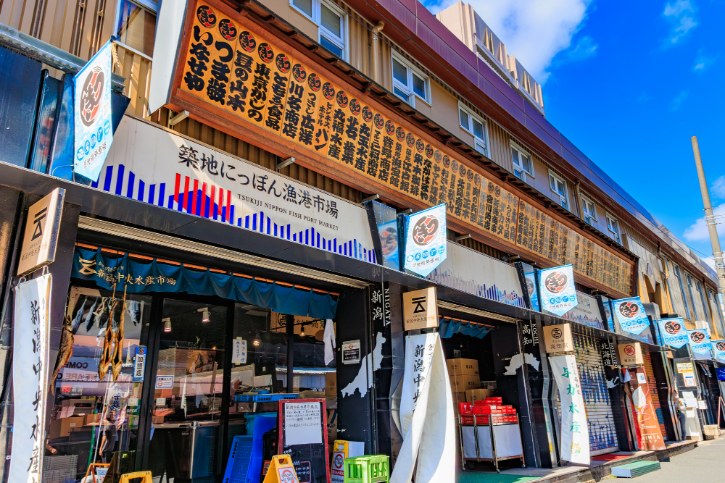
Tsukiji Outer Market is where you go for fresh seafood and street food.
The lanes are busy, friendly, and easy to explore. You see everyday Tokyo as vendors cook, call out, and serve at the stalls.
Besides food, you can shop for kitchen tools, ceramics, and food gifts. The market sits next to the former wholesale fish market, so the area has a long history.
What to Eat
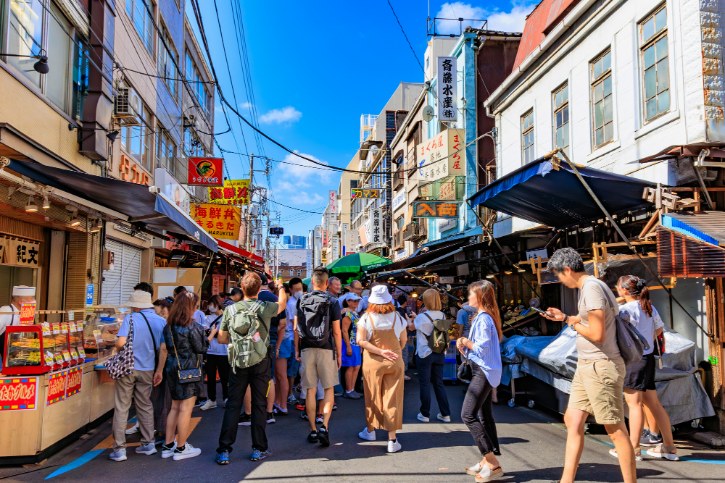
- Sushi breakfast: Many counters open early. Popular choices include Sushi Dai and Tsukiji Sushi Sei Honten.
- Street bites: Try tamagoyaki (Japanese omelette), grilled seafood skewers, and fresh oysters.
- Tamagoyaki to go: Look for Shouro and Marutake. They serve omelettes on sticks so you can eat while you walk.
Knife Shopping
- Visit Aritsugu and Masamoto for professional-grade Japanese knives. Staff can help you choose the right blade.
How to Get There
- Tokyo Metro: Hibiya Line to Tsukiji Station Exit 1. Walk about 6 minutes to the market entrance.
- Toei Oedo Line: Tsukijishijo Station Exit A1. Walk about 2 minutes to the market.
14. Hie Shrine
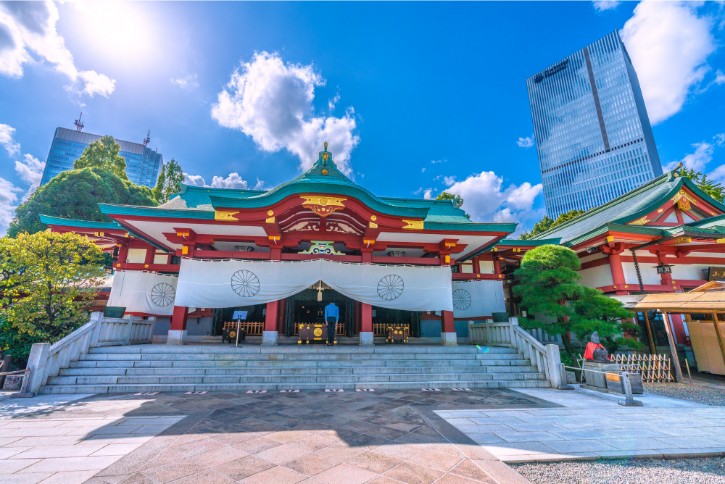
Hie Shrine is a well-known Shinto shrine in central Tokyo. You come here to pray for luck and success and to take a quiet break from the city.
The shrine began in 1478 and was rebuilt several times after fires and war.
The buildings you see now were completed in 1958.
Look for the rows of red torii gates and the monkey guardians. Trees and seasonal flowers add to the calm mood.
What to Do
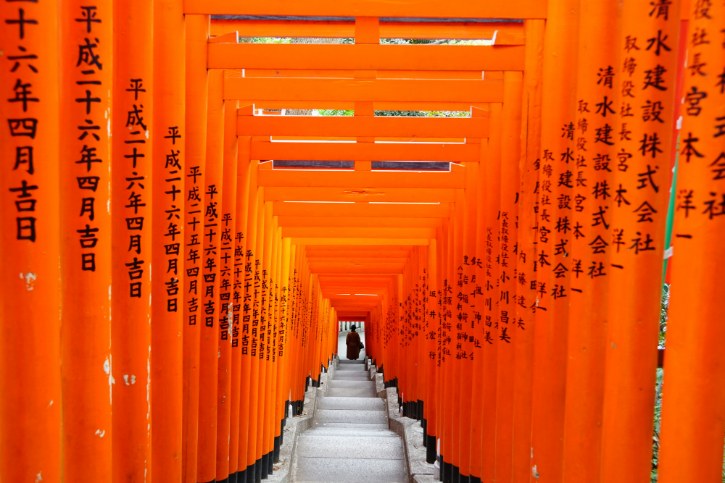
- Torii gate path: Walk the tunnel of bright red gates behind the main area. It makes a striking photo.
- Main hall (how to pray): Offer a coin, bow twice, clap twice, then bow once.
- Monkey statues: Spot the monkey guardians. They stand for good luck, success, and family protection.
- Treasure House: A small museum with historical and samurai items. It is usually open and free, but closed on Tuesdays and Fridays.
- Ema wish plaque: Write your wish on a wooden plaque and hang it at the shrine. Price: ¥1000.
- Omamori charms: Buy good-luck charms, including monkey designs. Price: ¥500 to ¥1000.
How to Get There
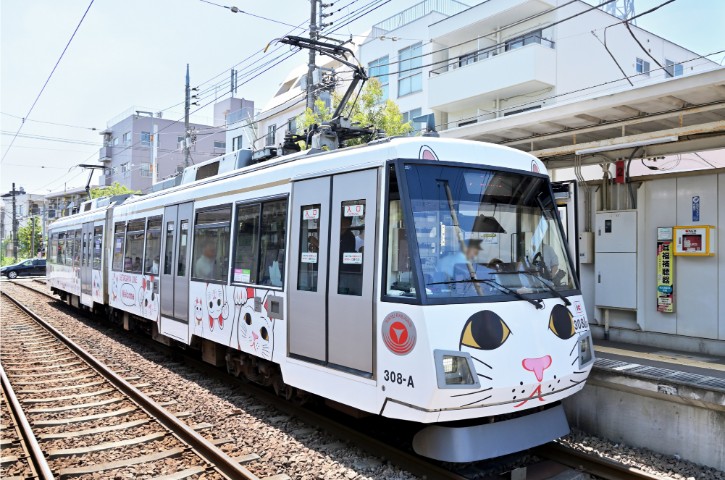
Tokyo Metro
- Ginza Line or Namboku Line to Tameike-Sannō Station Exit 7, about a 3-minute walk.
- Marunouchi Line or Ginza Line to Akasaka-Mitsuke Station Exit 11, about a 3-minute walk.
15. Ueno
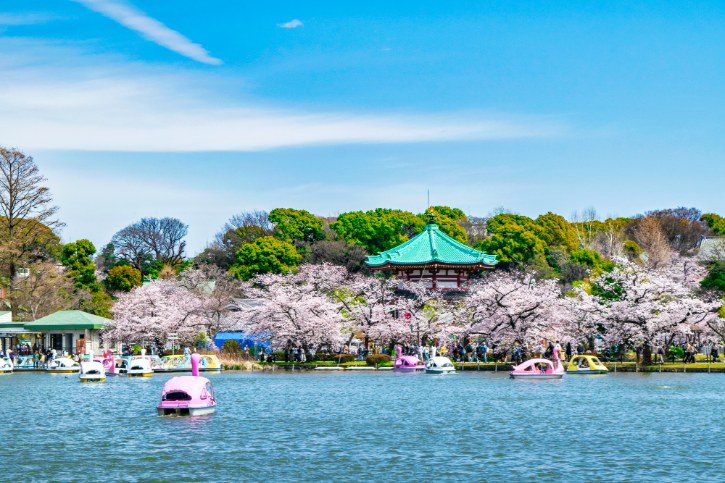
Ueno is easy to enjoy and easy to reach. You get a major park, a famous market street, and several top museums in one compact area.
The mood feels both cultural and down to earth. Shopping and food are affordable, and trains connect here from many parts of Tokyo.
Highlights
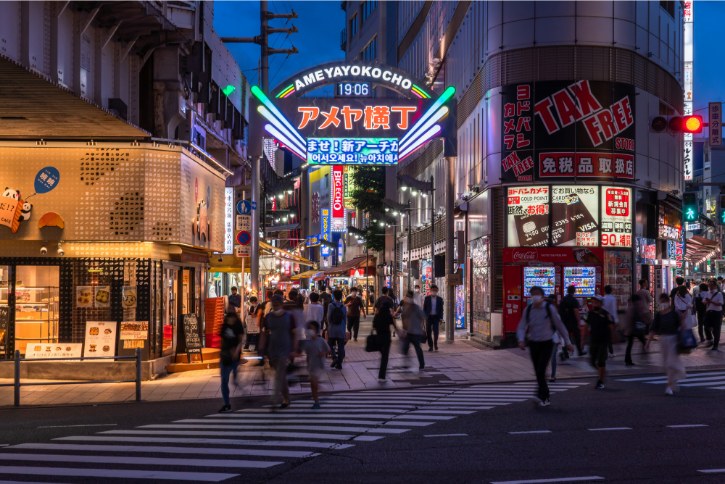
- Ameyoko Market: This lively street runs along the tracks with more than 400 shops. Look for snacks, clothes, souvenirs, and fresh seafood. It is busy and fun at any time, but evenings and weekends feel the most energetic.
- Ueno Park: Walk wide paths, relax by the pond, and enjoy seasonal views. Ueno Park is Japan’s first public park, so it mixes nature with history. In spring, about 1,200 cherry trees bloom and turn the park pink.
- World-class museums:
- Tokyo National Museum: Japan’s oldest museum with a deep collection of Asian art.
- National Museum of Nature and Science: Interactive exhibits that work for both adults and kids.
- National Museum of Western Art: European masterpieces displayed in a building designed by Le Corbusier.
- Ueno Zoo: Japan’s oldest zoo with more than 3,000 animals, famous pandas, and a five-story pagoda.
How to Get There
For Ueno Park, museums, and zoo:
- JR: Yamanote, Keihin-Tohoku, or other JR lines to Ueno Station. Use the Park Exit for direct access.
- Tokyo Metro: Ginza or Hibiya Line to Ueno Station Exit 7 for the park.
For Ameyoko:
- JR: Yamanote or Keihin-Tohoku Line to Ueno Station. Use the Shinobazu Exit. The market runs along the tracks outside.
- Tokyo Metro: Ginza or Hibiya Line to Ueno Station Exit 5B for Ameyoko.
- JR alternative: You can also use Okachimachi Station (North Exit) on the JR Yamanote Line. The market runs between Ueno and Okachimachi, so either station works well.
16. Odaiba
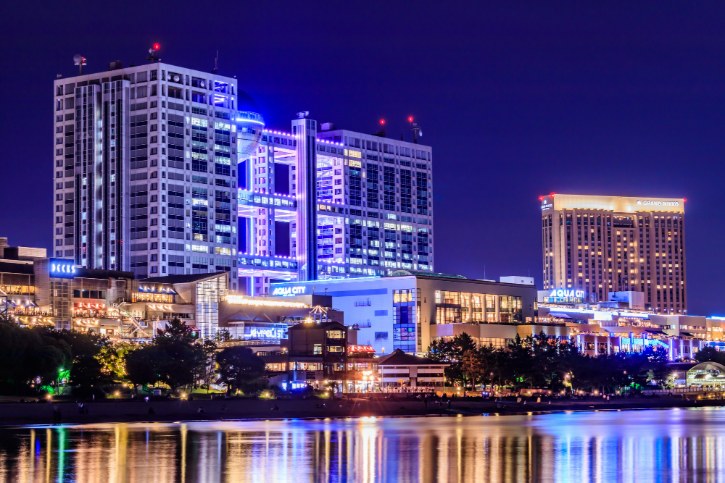
Odaiba is a large entertainment district built on a man-made island in Tokyo Bay.
It feels modern and futuristic, but also has wide open spaces where you can relax by the water.
You can shop, eat, and explore during the day, then enjoy beautiful views of Tokyo Bay and Rainbow Bridge at night.
Families, couples, and groups of friends will all find plenty to do here.
What to See and Do
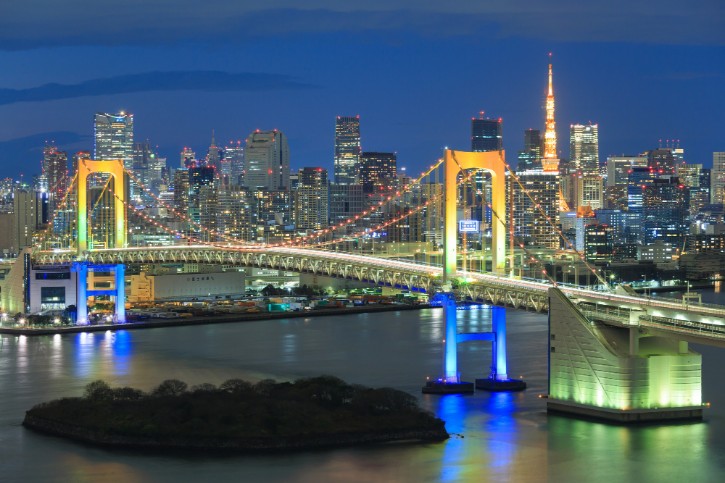
- Rainbow Bridge: The landmark bridge that connects Odaiba to central Tokyo. Visit at sunset or after dark to see the bridge lit up and the city skyline glowing in the distance.
- Fuji TV Building: This building is easy to spot with its giant silver sphere on top. You can ride up to the Hachitama observation deck inside the sphere for panoramic views of Tokyo Bay. On clear days, you may even see Mount Fuji.
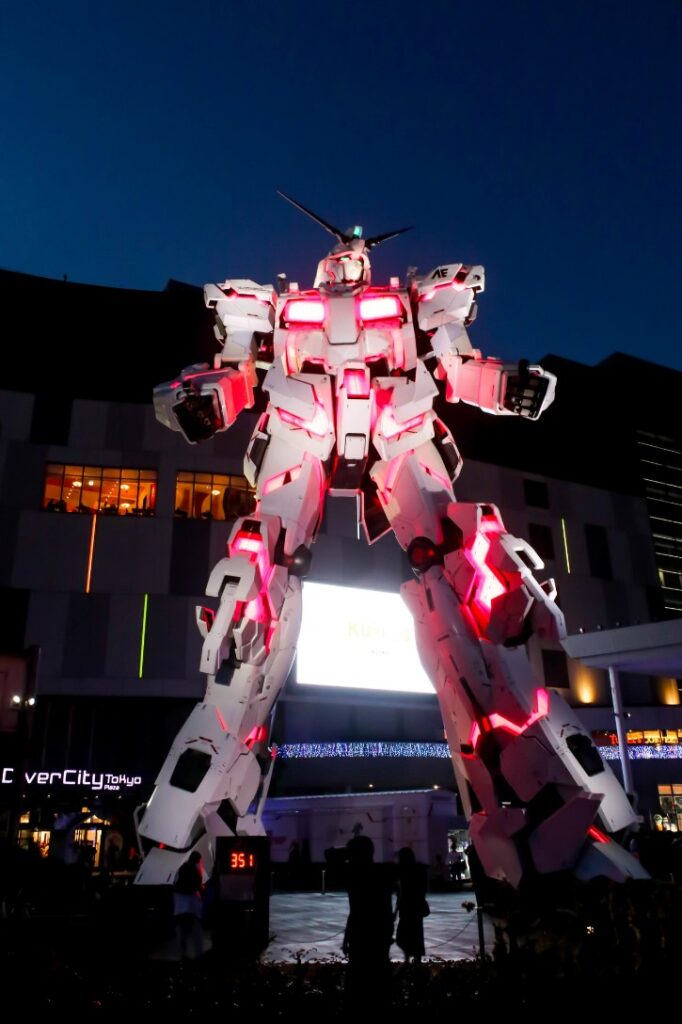
- Shopping and entertainment:
- DiverCity Tokyo Plaza: Famous for the life-size Unicorn Gundam statue outside. Inside, you’ll find a wide range of shops, fashion outlets, and restaurants.
- Aqua City: A shopping mall that also has great harbor views. It’s a good spot for dinner while watching the sunset over the bay.
- DECKS Tokyo Beach: Retro-style themed floors, indoor attractions, and plenty of seaside restaurants to enjoy.
- teamLab Borderless MORI Building: A digital art museum where the exhibits move and change with your presence. Walk through rooms of light, color, and interactive displays that feel alive. Tickets sell out fast, so it’s best to book in advance.
- Odaiba Marine Park: A waterfront park with an artificial beach where you can sit and relax. There’s also a mini Statue of Liberty, walking paths along the bay, and open spaces perfect for photos.
Read More: 17 Fun Things to Do in Odaiba (With Train Station Exit)
17. Harajuku
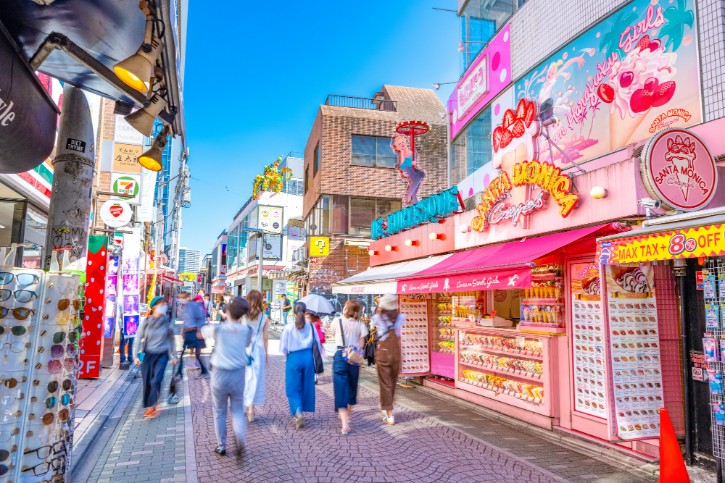
Harajuku is where you see Tokyo’s playful side and its traditional side in one visit.
On one street you find colorful fashion, sweets, and pop culture.
Just a short walk away, you step into a quiet forest with one of Tokyo’s most important shrines. That mix of fun and calm is what makes Harajuku special.
What to Do
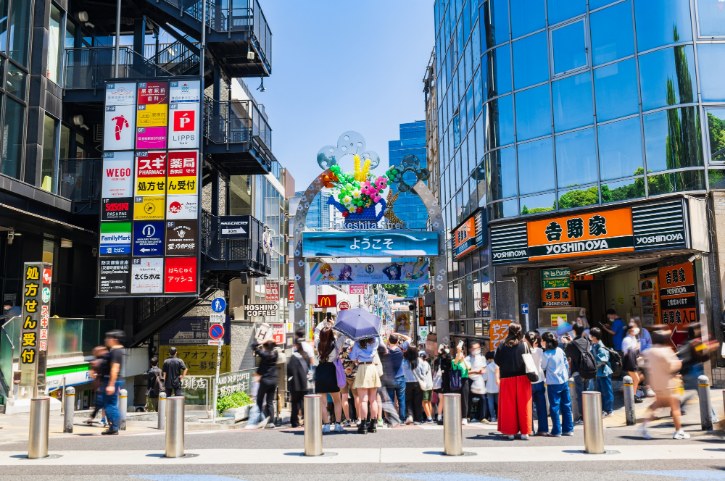
- Takeshita Street: This narrow, lively street is the heart of Harajuku. It is lined with fashion boutiques, crepe stands, souvenir shops, and photo booths. It is always busy, especially with young people and tourists, and gives you a taste of Tokyo’s youth culture.
- Meiji Jingu Shrine: Just behind Harajuku Station, you walk through giant wooden torii gates into a peaceful forest path. The atmosphere feels calm and sacred, a complete contrast to Takeshita Street.
- Omotesandō: A wide, tree-lined avenue that feels more elegant and upscale. You will find luxury brand shops, stylish cafes, and striking modern buildings such as Omotesando Hills and Tokyu Plaza.
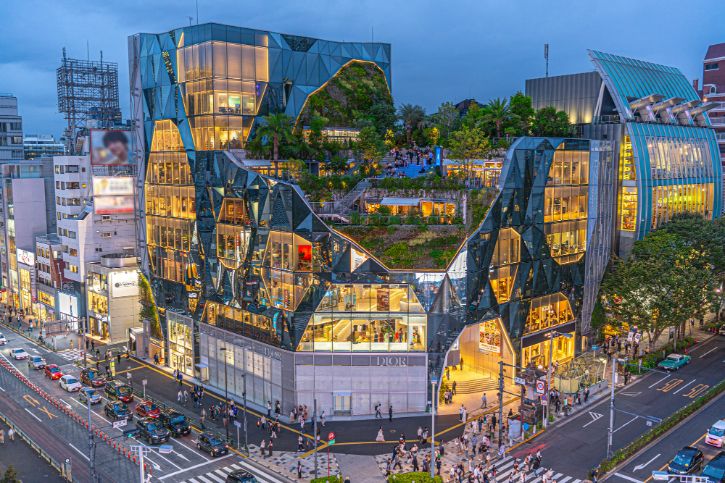
- Tokyu Plaza Harajuku Harakado: A new shopping and dining complex. The highlight is its rooftop terrace, where you can relax and enjoy free city views.
- Cat Street: A relaxed backstreet that connects Harajuku and Shibuya. It is filled with indie fashion stores, vintage shops, and cozy cafes. It is a great place to wander at a slower pace.
How to Get There
Most visitors start with Meiji Jingu Shrine and Takeshita Street, then walk to Omotesandō, Tokyu Plaza Harajuku Harakado, and Cat Street.
Takeshita Street:
- JR: Yamanote Line to Harajuku Station. Use the Takeshita Exit. The entrance is right in front.
- Tokyo Metro: Chiyoda or Fukutoshin Line to Meiji-Jingumae Station Exit 3. Walk about 2 minutes.
Meiji Jingu Shrine:
- JR: Yamanote Line to Harajuku Station. Use the Omotesando Exit. The shrine entrance is a 1-minute walk.
- Tokyo Metro: Chiyoda or Fukutoshin Line to Meiji-jingu-mae Station Exit 2. The entrance is directly across the street.
Map: 17 Must-Do Things in Tokyo
Related Posts
Photo Credit:
Photos by PIXTA

